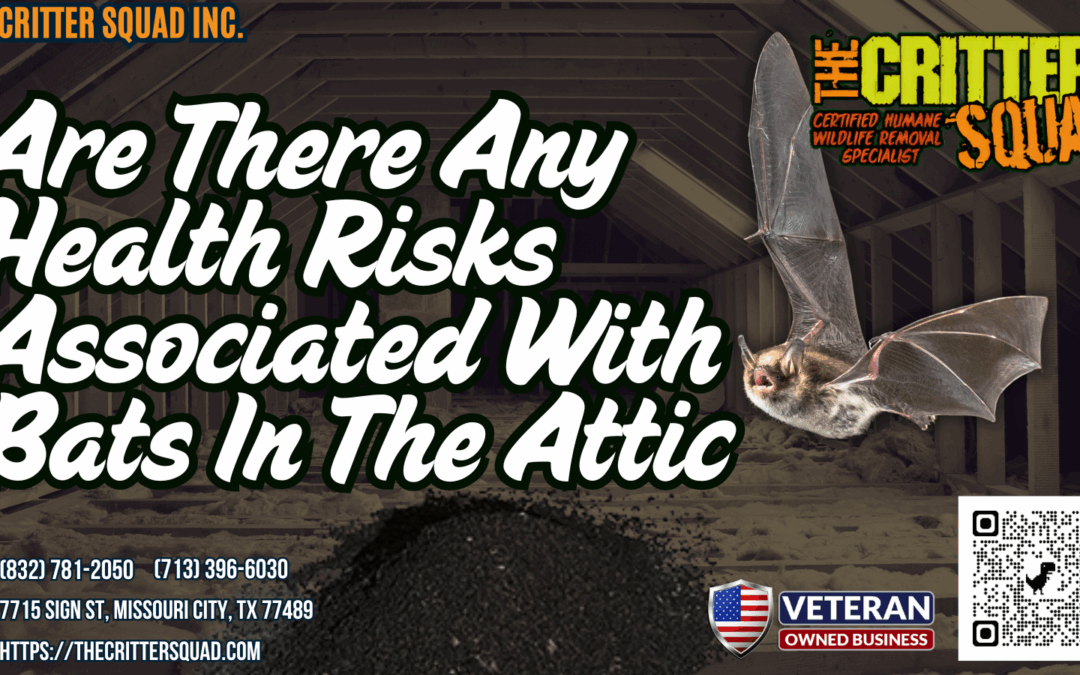Bats in the attic can pose health risks. They may carry diseases like rabies, which can spread through bites or scratches. Additionally, bat droppings can create allergens that lead to respiratory issues, especially for sensitive individuals. Misconceptions exist about bats being dangerous, but most avoid humans. It’s important to manage bats humanely and maintain a clean environment. Understanding their habits and risks can help. More information is available on how to safely coexist with bats.
Key Article Highlights
- Bats in the attic can carry zoonotic diseases, including rabies, which can be transmitted through bites or scratches.
- Bat droppings can produce allergens that negatively impact indoor air quality and may trigger respiratory issues in sensitive individuals.
- Accumulated bat waste can lead to mold growth, further degrading air quality and posing health risks.
- While most bats are not harmful, misconceptions can lead to unnecessary fear and misunderstanding of their ecological benefits.
- Seeking professional help for bat removal and ensuring proper sanitation can mitigate health risks associated with bats in the attic.
Understanding Bats and Their Habits
Bats are fascinating creatures that play important roles in the ecosystem. Their bat behavior is unique and interesting. Most bats are nocturnal, meaning they are active at night. This allows them to hunt insects and pollinate flowers when other animals are asleep. They use echolocation, a special sound system, to navigate in the dark. Bats often roost in large groups, finding shelter in caves, trees, and sometimes attics. This social behavior helps them stay safe from predators. Bats also communicate with each other through various sounds. Understanding their habits can help people appreciate these creatures and their contributions to nature. Additionally, learning about bat species guide can help identify different types of bats and their specific habits. As they fly freely in the night sky, they remind us of the beauty of wildlife and the importance of coexistence.
Common Health Risks Associated With Bats
Bats can pose several health risks to humans. They may carry zoonotic diseases that can be transmitted to people. Additionally, their droppings can cause allergens and respiratory issues.
Zoonotic Diseases Transmission
Although many people appreciate the ecological benefits of bats, these creatures can pose significant health risks when they inhabit residential areas. Bats are known carriers of zoonotic diseases, which can be transmitted to humans. Rabies is the most notable disease associated with bats, often resulting from bites or scratches. Understanding bat behavior is essential for disease prevention. Bats tend to roost in dark, secluded areas, making it important for homeowners to take precautions if bats are found in their attics. Avoiding direct contact and sealing entry points can reduce the risk of disease transmission. Awareness and proactive measures can help mitigate potential health risks while still respecting the role bats play in the ecosystem.
Allergens and Respiratory Issues
The presence of bats in attics can lead to various health concerns beyond zoonotic diseases. One major issue is the allergens produced by bat droppings. These droppings can dry out and become airborne, affecting indoor air quality. When inhaled, bat droppings may trigger asthma and other respiratory problems in sensitive individuals.
Additionally, the accumulation of waste can create an environment that fosters mold growth, further degrading air quality. This situation can lead to discomfort and health issues for anyone living in or near the affected area. It is essential for homeowners to address these concerns promptly to maintain a healthy living space and protect themselves from potential respiratory complications associated with bats in the attic.
Diseases Transmitted by Bats
When bats take up residence in an attic, they can pose significant health risks due to the diseases they may carry. Bats are known carriers of several illnesses, including rabies, which can be fatal to humans. Their droppings can also harbor histoplasmosis, a respiratory disease. Understanding bat behavior is essential for homeowners, as it helps in recognizing potential risks. Effective disease prevention involves safely removing bats and sealing entry points to prevent future infestations. Regular inspections and maintaining a clean attic can also reduce health hazards. Awareness of the diseases linked to bats is vital for safeguarding health and ensuring a safe living environment. Taking proactive steps can help mitigate the risks associated with these creatures.
Debunking Myths About Bats and Health Risks
How many misconceptions exist about bats and their health risks? Many people believe in common bat myths that suggest these creatures are dangerous and dirty. Some health misconceptions include the idea that all bats carry diseases or that they will attack humans. In reality, most bats are not harmful and help control insect populations. They tend to avoid contact with people and only bite if threatened. Rabies is a concern, but it is rare and mostly affects a small number of bats. Understanding these truths can help reduce fear and promote coexistence. It is essential to separate fact from fiction when considering the health risks associated with bats, allowing for a more informed perspective on these misunderstood animals.
Safe Practices for Coexisting With Bats

Many people can benefit from understanding safe practices for coexisting with bats. First, it is important to respect their role in bat conservation. Bats help control insect populations, which can be beneficial for gardens and crops. To coexist peacefully, homeowners should consider humane exclusion methods. This means sealing entry points only after bats have left for the season, allowing them to exit naturally. Installing bat houses nearby offers them a safe alternative for roosting. Avoid using harmful chemicals or traps, as these can endanger bat populations. By following these practices, individuals can enjoy the benefits of bats while ensuring their safety and well-being. Coexisting with bats is possible through awareness and respectful actions.
When to Seek Professional Help for Bat Removal
Determining the right time to seek professional help for bat removal can be challenging. Homeowners may notice signs of bats, such as droppings or strange noises, but might hesitate to act. It is important to seek professional services when the presence of bats is confirmed. Bats can carry diseases, and their droppings can pose health risks. If there are young children, pets, or anyone with a weakened immune system in the home, the urgency increases. Additionally, if bats are found inside living spaces, immediate action is necessary. Professional services can safely and humanely remove bats and prevent future infestations. Bat exclusion experts can assess the situation and implement effective cleanup and prevention measures. Taking swift action guarantees the safety and comfort of all residents while respecting wildlife.
Frequently Asked Questions
How Can I Tell if Bats Are in My Attic?
To determine if bats are in the attic, one can look for bat signs such as droppings or stains. Additionally, listening for attic noises during the night can indicate their presence.
Are Bat Droppings Harmful to Respiratory Health?
Approximately 30% of bat guano contains harmful spores. Bat guano toxicity can lead to respiratory issues when inhaled. Proper precautions are essential to prevent health risks associated with exposure to bat droppings in enclosed spaces.
What Legal Protections Exist for Bats in My Area?
The current question regarding legal protections for bats reveals that bat conservation laws and local wildlife regulations often exist. These regulations aim to protect bat populations, ensuring their preservation and promoting coexistence with humans in shared environments.
Can Bats Damage My Property or Insulation?
Bats can bring bothersome bat infestations, potentially causing significant insulation damage. Their droppings may deteriorate materials, leading to costly repairs. Homeowners should act promptly to protect their property and preserve peace of mind.
How Often Do Bats Return to the Same Roosting Site?
Bats often return to the same roosting site annually, driven by bat migration patterns. Their seasonal roosting habits guarantee they seek familiar locations, providing a safe space for resting and raising their young.

